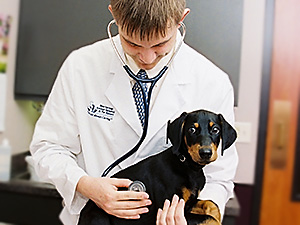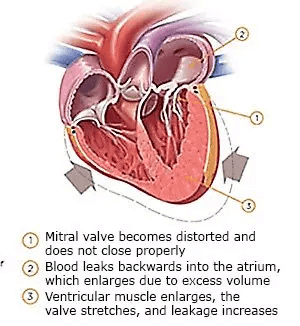Veterinary Cardiology & Echocardiography
Blue Springs Animal Hospital offers veterinary cardiology services in the Kansas City area, including echocardiography (heart ultrasound) to diagnose and treat heart murmurs and other conditions affecting the heart.
ANATOMY AND FUNCTIONThe heart pumps blood containing oxygen and nutrients through the blood vessels to the cells of the body. Heart disease in dogs causes a decrease in the ability of the heart to pump blood which leads to a build-up of fluid in the lungs or abdominal organs. The anatomy of a dog’s heart is very similar to a human heart. The heart has 4 chambers and blood flows from the two upper chambers, called atria, to the two lower chambers, called ventricles. Heart valves function like one-way doors to keep blood flowing in the correct direction through the heart. Venous (un-oxygenated) blood returning from the body enters the right atria, flows through the right side of the heart and is pumped from the right ventricle into the lungs. In the lungs the blood is oxygenated and returns to the left side of the heart where it flows from the left atria to the left ventricle and is pumped through the aorta back out to the body. |
|
||
HEART MURMURSHeart murmurs are abnormal heart sounds caused by aberrant blood flow, for example by leaky heart valves allowing blood to flow backwards through the heart chambers or major vessels. Heart murmurs often create a “shhhussh” kind of sound which can be heard between the normal “LUB” and “DUB” heart sounds. A heart murmur indicates an abnormality of the heart, but does not definitively identify a specific heart disease. There are multiple heart diseases which can cause heart murmurs. Diagnosis of the heart disease causing a murmur requires an evaluation of the dog’s history, physical exam, and diagnostic tests like radiographs (Xrays) and echocardiography (ultrasound of the heart). |
 |
||
HEART DISEASES IN THE DOGApproximately one in ten dogs (10%) will develop some form of heart disease during their lifetime, and approximately 80% of the heart disease is due to primary mitral valve disease (MVD). Valve disease is frequently diagnosed in small breed dogs, especially Cavalier King Charles Spaniels, Poodles, Schnauzers, Pomeranians, Chihuahuas, and small terrier breeds. Valve disease is potentially a very manageable heart condition with proper diagnosis and treatment. Therefore our cardiology services focus heavily on identifying and treating patients with valve disease. Other less common heart diseases in dogs include:
|
 |
||
VALVULAR HEART DISEASEThe atrioventricular (AV) valves located between the atria and ventricles are the commonly affected valves, particularly the mitral valve between the left atrium and ventricle. Primary mitral valve disease is usually a degenerative disease, meaning as the valve ages it deteriorates and wears out over time. Disease of the valve tissue prevents the valve from closing properly allowing blood to leak backward from the ventricle into the atrium. As the valve malfunctions and blood flows backwards there is diminished blood flow from the heart out to the body (referred to as reduced cardiac output). Diminished flow to the body signals the heart to work harder and the heart muscle enlarges. As the heart enlarges the valves are pulled further apart, leakage and backflow increase, the cycle repeats, and heart damage progresses. Eventually the heart can no longer pump hard enough to overcome the backflow from a leaky valve. Fluid backs up in the lungs or abdomen causing clinical symptoms and illness. Early diagnosis and treatment for valvular disease has proven to significantly delay the onset of symptoms and illness and prolong the pet’s life span. |
 |
||
CARDIOMYOPATHYCardiomyopathy in dogs is usually a type called dilated cardiomyopathy (DCM). It is a disease which causes weakness of the heart muscle and progressive dilation of the heart chambers. Due to the breed predisposition of Cockers, Dobermans, Boxers, Great Danes and other giant breeds, there is thought to be an inherited factor, but the exact cause is poorly defined. Recently there have also been cases of DCM in non-typical breeds which may have a nutritional link to feeding grain free, exotic protein, or home cooked diets. This may be due to a deficiency in protein sources which contain adequate taurine, but it is an area under continued investigation. For now we feel it is best to err on the side of caution and avoid such diets. Please call if you have been feeding one of these diets and are concerned or if you would like a recommendation for your pet’s diet. More information on DCM linked to nutrition is available here and here. |
 |
||
SYMPTOMS OF HEART DISEASEEventually as the heart deteriorates the cardiac output to the body decreases and fluid begins to build up in the lungs or abdomen. This clinical stage of heart disease when symptoms become present is commonly referred to as congestive heart failure (CHF). Clinical symptoms of heart disease may include coughing, difficulty breathing, increased respiratory rate, abdominal distension, exercise intolerance, weakness, reluctance to move, depression or withdrawal, poor appetite, restlessness, fainting or collapsing, and sudden death. Ideally diagnosis and treatment will occur prior to the development of clinical symptoms. As heart disease progresses symptoms will worsen and further treatment will be needed. Development of difficulty breathing, abdominal distension, or fainting indicates an urgent situation requiring immediate medical intervention. |
 |
||
DIAGNOSIS OF HEART DISEASEIt is important to work with a veterinarian who has advanced training in cardiology and access to the high tech equipment necessary to properly diagnose heart disease.
Cardiac Radiology (Xrays)Radiographs provide information on heart size, shape, and position. Abnormalities indicate specific changes within the heart due to heart disease. Radiographs also allow visualization of the lungs and indicate whether fluid is backing up from the heart into the lungs due to heart failure. The high def images captured with our equipment allow visualization of more subtle or early changes than low def images captured on standard radiology equipment. Echocardiography (Ultrasound of the heart)Echocardiography is a non-invasive specialized ultrasound imaging technique which allows visualization of the heart including the walls, chambers, and valves.
|
|
||
TREATMENT FOR HEART DISEASERecent advances in diagnosis and therapy have greatly improved the effectiveness of treatment for heart disease. Specific treatment depends on the underlying disease, but a key element of success is establishing a relationship with a veterinarian who is skilled in cardiology and can assist in decisions regarding therapy. Treatment TimingWhen treatment should start depends on the type of heart disease and how far the heart disease has progressed. In the past dogs with valve disease were not treated until the dog began to show signs of discomfort and illness. A recent study has shown that earlier diagnosis with echocardiography and treatment with pimobendan (Vetmedin) can delay the onset of symptoms and illness by an average of 15 months – that is over 9 years in dog years! Pre-symptomatic treatment with pimobendan is ideal, but it should not be started until the valve disease has caused heart enlargement. Therefore it is important to accurately assess heart size and function with radiographs and echocardiography. The best decision regarding treatment can be made when normal baseline radiographs and echocardiogram measurements can be compared over time with subsequent abnormal results. Treatment OptionsHeart disease treatment is initiated in a step-wise fashion dependent on the pet’s diagnosis, symptoms, and progression. Monitoring both at home and with regular veterinary evaluations is important in order to adjust therapy based upon the individual patient’s needs. Treatment options generally include various medications, dietary sodium restriction, exercise modification, prevention of heartworms, and dental care to avoid blood borne infections. |
|
||
HOME CARE AND MONITORINGCaring for a dog with heart disease is both rewarding and challenging. Important considerations in treatment include:
One important thing pet caretakers can do is monitor respiratory rate. An increase in respiratory rate while sleeping or resting quietly is an early indicator of heart dysfunction. Count the number of breaths in 10 seconds and multiply by 6 (or set a timer for 30 seconds and multiply by 2.) If the resting rate exceeds 30 breaths per minute notify the veterinarian. In addition to monitoring respiratory rate dogs should be monitored for the development of new symptoms or worsening of existing symptoms of heart disease. Any change could indicate a need for adjustment or addition to the current treatment. |
|











